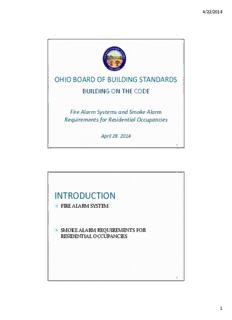
Fire Alarm Systems and Smoke Alarm Requirements for Residential Occupancies PDF
Preview Fire Alarm Systems and Smoke Alarm Requirements for Residential Occupancies
4/22/2014 OHIO BOARD OF BUILDING STANDARDS BUILDING ON THE CODE Fire Alarm Systems and Smoke Alarm Requirements for Residential Occupancies April 28, 2014 1 INTRODUCTION FIRE ALARM SYSTEM SMOKE ALARM REQUIREMENTS FOR RESIDENTIAL OCCUPANCIES 2 1 4/22/2014 COVER UNDERSTAND REASONS FACTS FIRE DEFINITIONS RESIDENTIAL CODE APPLICATION OHIO BUILDING CODE APPLICATION NFPA STANDARDS PLAN EXAMINATION INSPECTION 3 CODES AND STANDARDS 2013 RCO 2011 OBC UPDATES NFPA 72‐2010 OHIO FIRE CODE 4 2 4/22/2014 OVERALL WHO IS INVOLVE? OWNER DESIGN PROFESSIONAL CONTRACTOR BUILDING OFFICIAL PLANS EXAMINER BUILDING INSPECTOR FIRE OFFICIAL 5 WHAT ARE WE TALKING ABOUT??? LIFE SAFETY OF HUMAN BEINGS ENFORCE THE CODE REQUIREMENTS APPLY THE PROPER STANDARDS GET THE PROPER PERMIT INSPECTION 6 3 4/22/2014 FACTS When a fire breaks out, you have only seconds to escape its heat, black smoke and deadly gases. You can dramatically increase the chances of surviving a fire simply by installing and maintaining working smoke alarms in your home. 7 FACTS About 3,400 Americans die each year in fires and about 17,500 are injured. Smoke alarms have been and still are the cornerstone of fire safety technology in the home. Smoke alarms and home escape planning are still a vital part of survival from fire A fifty percent reduction in fire fatalities since the introduction of smoke alarms into the home 8 4 4/22/2014 FACTS Although 90% of all residences have smoke alarms today, no smoke alarms were present in 42% of residential structure fires where fatalities occurred. Smoke alarms were present in 58% of fatal residential structure fires, but only operational in 37% of those fatal fires Most often where smoke alarms are present in a fatal fire, the smoke alarm is nonfunctional due to dead or missing batteries. 9 FACTS Need for home escape planning Smoke alarms are a tool in the planning process Hold a fire drill at night (activate your alarm) while your children are sleeping so that you and they can determine the appropriate response to a smoke alarm. 10 5 4/22/2014 Fire in Ohio In 2010 the fire death rate was 13.9 per 1 million residents The relative risk of dying in a fire was 1.2 11 12 6 4/22/2014 Residential Fire Basics Most residential fires occur during the winter months of December, January, and February Reported home fires peak during the dinner hours of 5 PM to 8 PM Cooking equipment is the leading cause of reported fires Smoking materials cause the largest number of fatalities Most fire deaths resulted in environments with no smoke alarm 13 Conditions that affect response to fires Intoxication Alcohol contributes to about 40% of residential fire deaths Sleeping Half of all home fire deaths resulted from incidents reported between 11 PM and 7 AM Home Vacancy Fire spread beyond building of origin in 10% of vacant comes, compared to 3% of home fires overall Physical, Mental, or Sensory Disability 14 7 4/22/2014 Populations at Risk People 65 and older Men African Americans and American Indians Residents of the American South Low socioeconomic status 1145 14 http://www.usfa.fema.gov/statistics/ 16 8 4/22/2014 http://www.usfa.fema.gov/statistics/ 17 http://www.usfa.fema.gov/statistics/ 18 9 4/22/2014 http://www.usfa.fema.gov/statistics/ 19 Compartment Fire Development 2190 10
Description: